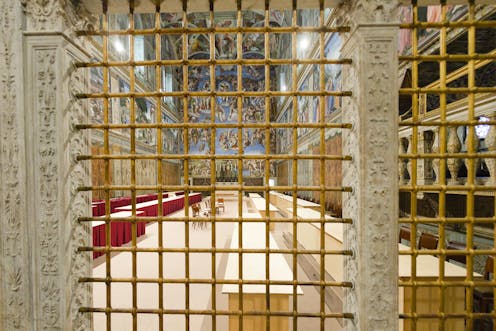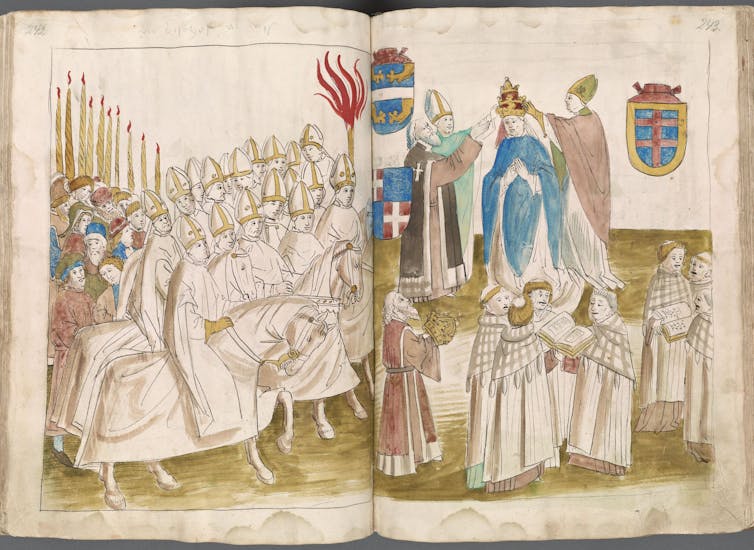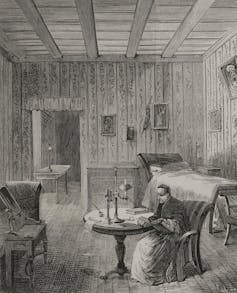
I’m a historian of the medieval papacy and editor of the forthcoming three volumes of the Cambridge History of the Papacy. So it was more or less mandatory for me to see the new movie “Conclave.”
Based on Robert Harris’ 2016 novel, the film shows the politics behind electing a pope to lead the world’s 1.36 billion Catholics. Any researcher who has spent some time at the Vatican will find familiarity in the characters’ speeches and behaviors, which are acted spot-on.
What the movie does not do, though, is explain where the word “conclave” comes from, and how the mysterious system was created in the first place. Conclave is formed from the Latin words for “with key,” referring to how cardinals are sequestered to elect a pope – inside the Vatican, today; but wherever a pope died, in the Middle Ages.
Why sequestered? Because it took centuries for the church to develop an electoral system free from manipulations and violence – which should resonate with contemporary politics.
Chosen by ‘the people’?
Once free from Byzantine and Holy Roman imperial controls, from the end of the 11th century forward, a medieval pope held powers far superior to the ones a pope holds today. Not only did he offer spiritual guidance, but the pope was heavily engaged in political affairs, including negotiations between states, and was head of the wealthiest institution around, collecting taxes and revenues from most of Europe.

Electing this powerful figure was a cantankerous affair, marred by violence and external interference.
Originally, in early Christianity, the pope had been nominated by the “people of Rome” agreeing by consensus. In reality, that meant the election was in the hands of mobs, aristocrats, kings, emperors or anyone with any form of control over Rome. Consensus was achieved by either negotiation or force. Quite often, powerful people could appoint whomever they chose.
For example, the 686 election of Pope Conon is described in “The Book of Pontiffs,” a medieval collection of short papal biographies, as a chaotic affair that included the military. The author states that “there was much argument, since the clergy favoured the archpriest Peter while the army were for Theodore, the next in seniority.” After long negotiations the clergy opted for Conon, who had been third in rank under the late pope.
Sacking the Vatican
In addition to “internal” pressures, a pattern emerged of mobs sacking the goods of the dead pope – sometimes including the clothes on his corpse and his liturgical garments. It is difficult to identify why: greed, certainly, and obtaining something that had been touched by holy men. But I would argue the mob also resented authorities who took the nomination process away from “the people.”
The Council of Chalcedon, a gathering of bishops in 451, forbade clerics from seizing a dead bishop’s belongings, at risk of losing their rank. Another council a few years later decreed: “Let no one, through theft, force, or deceit, conceal, take away, or hide anything” at the death of a bishop.
Yet looting went on for centuries. In a 1050 letter to Catholics in the diocese of Osimo, in present-day Italy, Cardinal Peter Damian stated:
From various reports we are aware of the perverse and wholly detestable practice of certain people, who at the death of the bishop break in like enemies and rob his house, like thieves make off with his belongings, set fire to the homes on his estate, and with fierce and savage barbarity cut down his grape vines and orchards.
The movie may be alluding to this history when a cardinal asks Dean Lawrence, the man presiding over the conclave, if he could have the deceased pope’s chess game.
College of Cardinals
To salvage the electoral system from internal and external chaos, Pope Nicholas II decreed in 1059 that popes should be selected by men of the cloth – namely, cardinal-bishops. Up to then, cardinals had been involved in liturgical functions in the great basilicas of Rome. They could be priests, deacons or bishops.

This did not work. A century later, Pope Alexander III decreed that all the cardinals – with equal representation between priests, deacons and bishops – would become the pope’s electors, and a nominee needed to secure two-thirds of the votes to win.
Still, intrigues and squabbles continued to mar the process for years. So long as there was a “Vacant See” at the Vatican, the cardinals were the church’s governors, so the incentive was on their side to delay the process.
And the looting expanded, with cardinals’ residences becoming new targets. Sacking would sometimes take place even before the pope was dead, as rumors of a selection circulated.
Strict secrecy
The continued chaos, as well as cardinals’ lengthy negotiations and ongoing external influences, pushed Pope Gregory X to act. In 1274, he instituted the decree “Ubi periculum.” The first words of the text were “Ubi periculum maius intenditur”: “Where greater danger lies.” A papal nomination was dangerous business – sometimes to the person, most often to his property.
“Ubi periculum” established the basics of the conclave system still used today – most importantly, that cardinals would be completely isolated and confined during the process.

Sequestered cardinals would not tarry in long discussions, especially when they were away from the comfort of their own palaces, allowed only a single attendant and sleeping in simple cells. If they took longer than three days to decide, they lost the privilege of several daily meals, down to a single one. The politics of the stomach!
Incidentally, the traditional looting now spread to the cells of the conclave.
Two popes
Under the new rules, the role of the cardinals was strictly limited to electing the next pope. But this did not prevent them from continuing their scheming.
At the death of Gregory XI in 1378, the cardinals elected Pope Urban VI, but soon regretted it. A few months later, they deposed him and elected a new one, under the pretext that the first election took place under duress: the fear of the mobs. Still, they knew full well that the looting was “customary.”
The chronicler Dietrich of Niem, a witness to the events, made that clear. After Urban had been chosen – unanimously – “he immediately moved his books and other valuables into a safe place, so that they would not be stolen,” Dietrich wrote. He added, “It is a custom of the Romans to go in his palace and rob his books and things of this kind.”
Catholics now had two popes: the one who had been elected in April 1378 – Urban VI, who refused to give up power – and the one elected in September 1378, Clement VII. Two popes, two courts and two “obediences” divided Europe. The crisis, which lasted from 1378-1417, is called the Great Western Schism.
Power is tantalizing – and electoral violence and manipulation are not new.
Joelle Rollo-Koster does not work for, consult, own shares in or receive funding from any company or organization that would benefit from this article, and has disclosed no relevant affiliations beyond their academic appointment.
This article was originally published on The Conversation. Read the original article.







